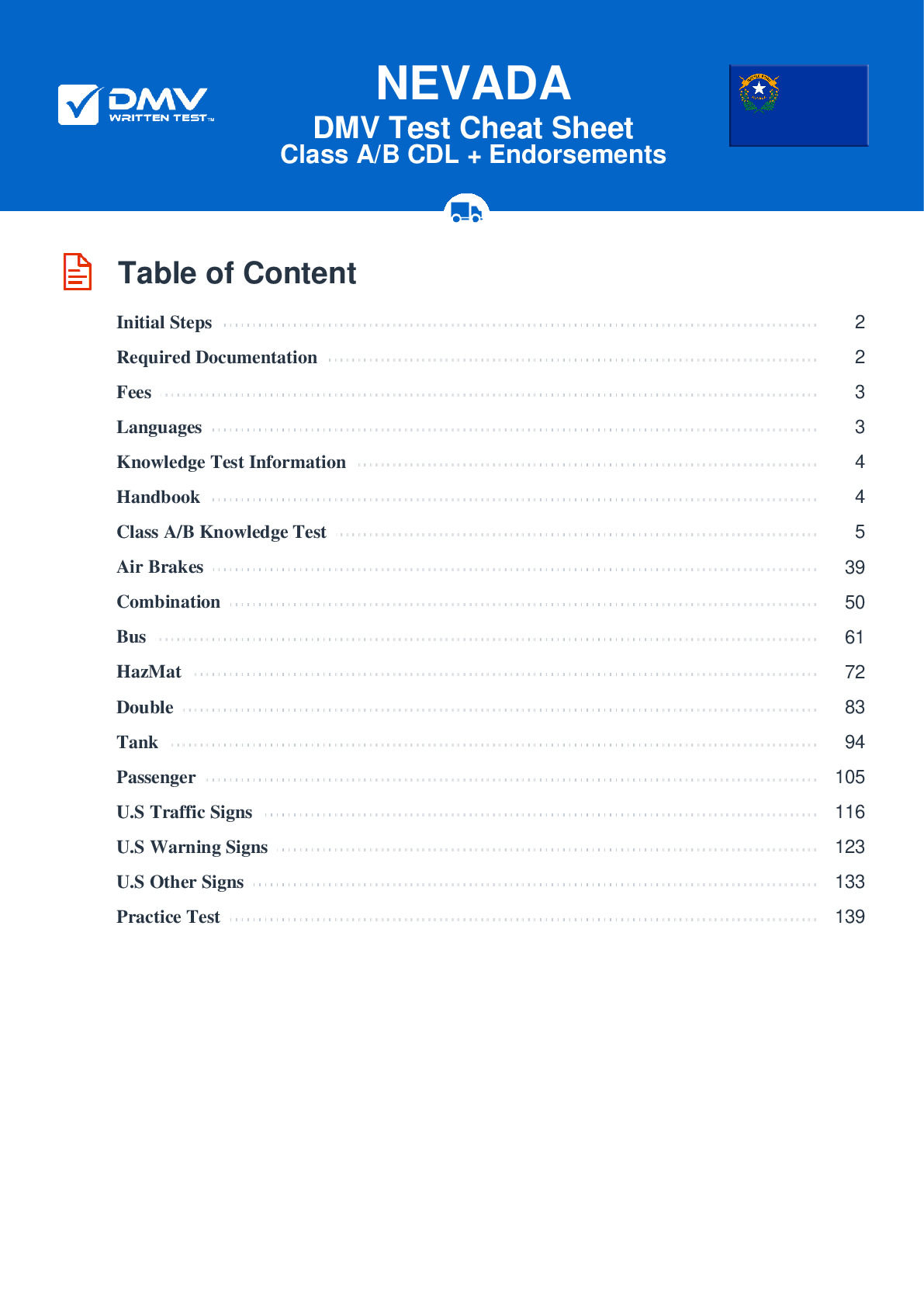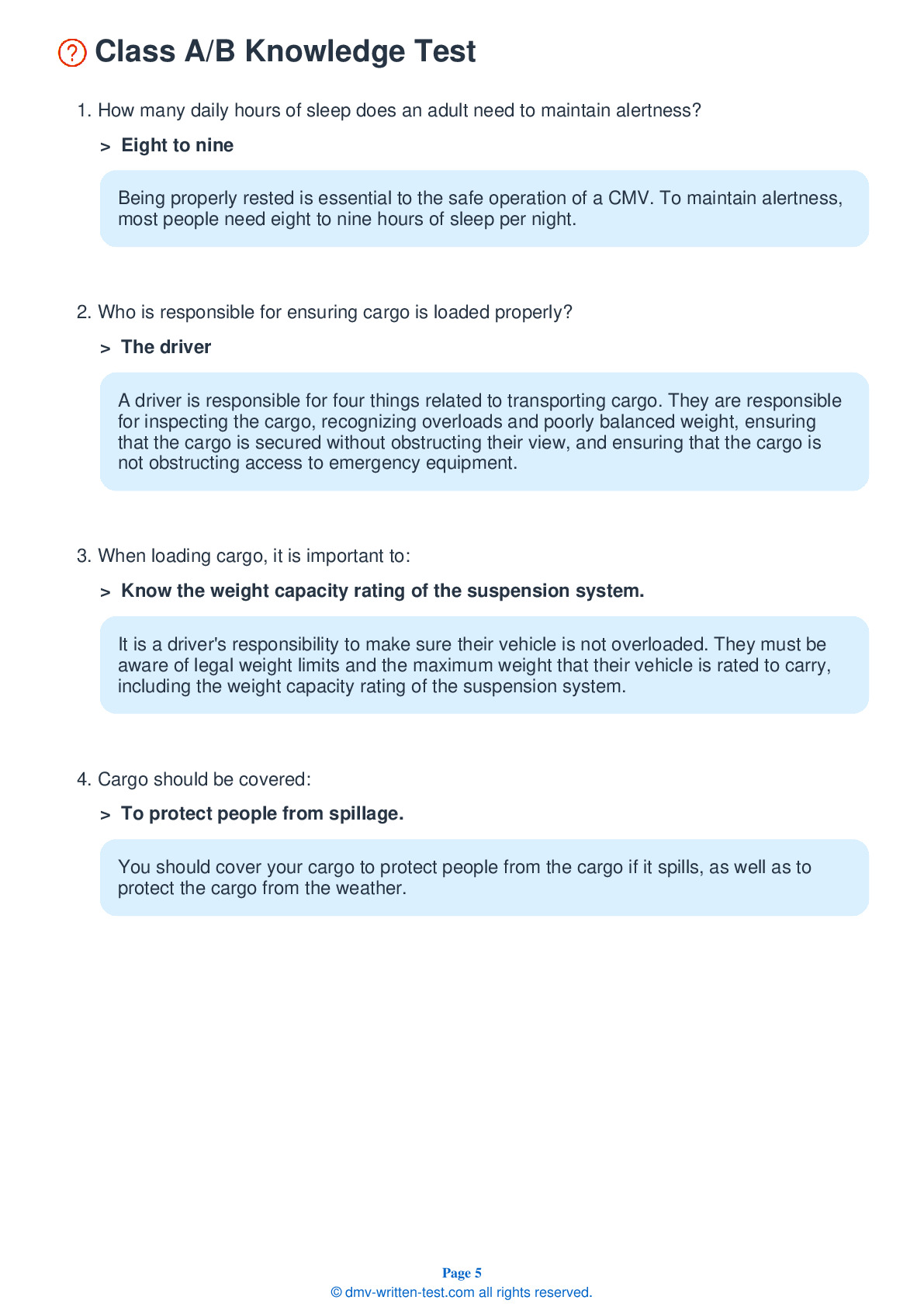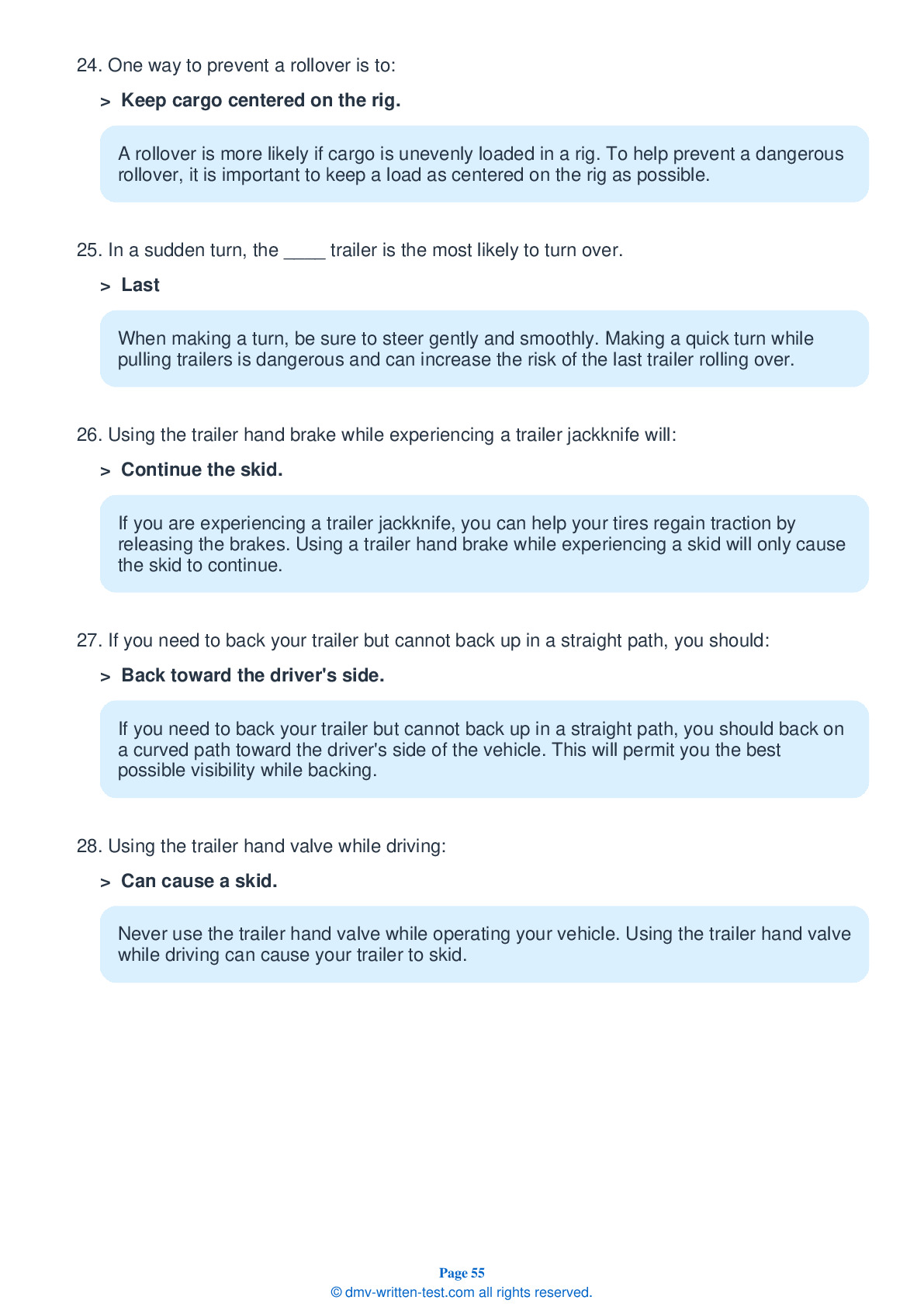Knowledge Test Class B
This license is required for driving a single vehicle with a GVWR of more than 26,001 pounds, and a trailer not to exceed 10,000 pounds gross vehicle weight rating, or a vehicle designed to transport 24 or more people (including the driver). To receive this license, applicants must pass a 50-question test. To pass, applicants must answer 40 questions correctly. Each question has three or four possible answer choices. Test questions come from the Nevada Commercial Driver License Manual. Questions come from chapters covering: Introduction, Driving Safely, Transporting Cargo Safely, Air Brakes (if applicable), Pre-Trip Vehicle Inspection Test, Basic Vehicle Control Skills Test and On-Road Driving.. Endorsements that may be used with a Class B CDL are: Hazardous materials, Tank, Passenger, HazMat and Tank, Air Brakes and School bus.
1. When driving under wet conditions, what does a lack of spray from other vehicles indicate?
If the road appears to be wet but the wheels of other vehicles are no longer generating spray, ice has formed on the road. Drive with extra caution when operating on wet or icy roads.
2. When a vehicle is started:
After starting a vehicle's engine, you should see the warning lights and buzzers go out right away. If they remain on, there is something wrong with your vehicle.
3. Radial and bias-ply tires:
When inspecting your vehicle, ensure that radial and bias-ply tires are not being used together.
4. If a vehicle is equipped with power steering, you should inspect:
When inspecting a vehicle with power steering, check the hoses, pumps, and fluid level. In particular, you should look for leaks in the hoses.
5. Overloading a vehicle with cargo can affect all of the following, except:
Overloading can have negative effects on a vehicle's steering, braking and speed control.
6. What must be on an air tank in an air-braked vehicle?
All air tanks on air-braked vehicles must have one-way check valves located between the air compressor and the first reservoir. This prevents air from flowing out in the event of a leak.
7. If approaching a railroad crossing while driving a placarded vehicle, you should always:
If approaching a railroad crossing while driving a transit bus, school bus, or placarded vehicle, special procedures apply. Before crossing, stop your vehicle within 50 feet of, but not less than 15 feet from, the nearest rail. Activate your four-way flashers while crossing. Do not stop, change gears, or change lanes while any part of your vehicle is proceeding across the tracks.
Frequently Asked Questions
Here are the steps to obtain a Class B CDL license in Nevada:
1. Obtain and study the Nevada Commercial Driver's License Handbook provided by the Nevada Department of Motor Vehicles (DMV).
2. Schedule an appointment at your local DMV office to take the written knowledge test for the Class B CDL license. You will need to provide proof of identity and residency, as well as pass a vision test.
3. Pass the written knowledge test by answering at least 80% of the questions correctly.
4. Obtain a learner's permit by passing a skills test in a vehicle similar to the one you will be driving with your Class B CDL.
5. Practice driving with your learner's permit and prepare for the skills test by reviewing the Nevada Commercial Driver's License Handbook and taking practice tests.
6. Schedule an appointment at your local DMV office to take the skills test for your Class B CDL license.
7. Pass the skills test, which includes a pre-trip inspection, basic control skills, and an on-road driving test.
8. Pay the required fees and obtain your Class B CDL license from the DMV.
It is important to note that additional endorsements may be required for certain types of vehicles or cargo, such as hazardous materials or passenger transportation.
Some examples of vehicles you can operate with a Class B CDL license include:
- Straight trucks
- Large buses (such as school buses)
- Segmented buses
- Box trucks
- Dump trucks
- Cement mixers
- Tow trucks (with a GVWR or GCWR of 26,001 pounds or more)
- Small tractor-trailers (with a GVWR or GCWR of 26,001 pounds or more, but the towed vehicle(s) have a GVWR of less than 10,000 pounds)
It is important to note that additional endorsements may be required for certain types of vehicles or cargo, such as hazardous materials or passenger transportation.
1. Be at least 18 years old for intrastate (within Nevada) driving or 21 years old for interstate (across state lines) driving.
2. Hold a valid Nevada driver's license.
3. Provide proof of identity and residency.
4. Self-certify the type of commerce you will be operating in (interstate or intrastate).
5. Pass a medical examination and obtain a medical certificate from a certified medical examiner listed on the National Registry of Certified Medical Examiners.
6. Obtain and study the Nevada Commercial Driver's License Handbook provided by the Nevada Department of Motor Vehicles (DMV).
7. Pass a written knowledge test at your local DMV office that covers general knowledge, air brakes, and combination vehicles (if applicable).
8. Obtain a learner's permit by passing a skills test in a vehicle similar to the one you will be driving with your Class B CDL.
9. Practice driving with your learner's permit and prepare for the skills test by reviewing the Nevada Commercial Driver's License Handbook and taking practice tests.
10. Pass a skills test that includes a pre-trip inspection, basic control skills, and an on-road driving test in a vehicle similar to the one you will be driving with your Class B CDL.
11. Pay the required fees and obtain your Class B CDL license from the DMV.
It is important to note that additional endorsements may be required for certain types of vehicles or cargo, such as hazardous materials or passenger transportation, which may require additional tests or training.
However, there are some exceptions to this rule. If you are between the ages of 18 and 21, you may still be eligible to obtain a CDL license for intrastate commerce only, provided you meet the following conditions:
1. You have held a valid driver's license for at least one year.
2. You have no serious traffic violations on your driving record.
3. You have no convictions for driving under the influence (DUI) of drugs or alcohol.
4. You pass a medical examination and obtain a medical certificate from a certified medical examiner listed on the National Registry of Certified Medical Examiners.
5. You complete a driver training program that meets Federal Motor Carrier Safety Administration (FMCSA) standards.
It is important to note that even if you meet these conditions, not all carriers may be willing to hire drivers under the age of 21 due to insurance requirements or company policies.
Here are the most common endorsements for Class B CDL drivers in Nevada:
1. Passenger (P) - Required for drivers who will be transporting 16 or more passengers, including the driver.
2. School Bus (S) - Required for drivers who will be operating a school bus to transport students.
3. Tank Vehicles (N) - Required for drivers who will be transporting liquids or gases in bulk containers with a capacity of 1,000 gallons or more.
4. Hazardous Materials (H) - Required for drivers who will be transporting hazardous materials in amounts that require placards.
5. Combination Vehicles (T) - Required for drivers who will be operating a combination of vehicles with a total weight of 26,001 pounds or more.
It is important to note that obtaining an endorsement typically requires passing a specialized knowledge test and, in some cases, a skills test. Additionally, you must meet certain eligibility requirements and provide additional documentation, such as proof of training or security clearance, to obtain certain endorsements.
1. Pre-trip Inspection Test: This portion of the test evaluates your ability to inspect your vehicle to ensure that it is safe to operate. You will be asked to identify and explain the function of various parts of the vehicle, such as brakes, lights, tires, and steering components.
2. Basic Vehicle Control Test: This portion of the test evaluates your ability to control the vehicle in various driving situations. You will be asked to perform maneuvers such as backing up in a straight line, turning within a confined space, and parking in a designated area.
3. Road Test: This portion of the test evaluates your ability to safely operate your vehicle on public roads and highways. You will be asked to demonstrate your ability to perform basic driving maneuvers such as turning, changing lanes, merging onto a highway, and driving in traffic.
It is important to note that you must provide a vehicle that meets certain requirements for the skills test, including proper insurance and registration documentation. Additionally, you must pass each portion of the skills test with a score of 80% or higher to obtain your Class B CDL license.
1. Vehicle type: You are only authorized to operate a single vehicle with a gross vehicle weight rating (GVWR) of 26,001 pounds or more or any such vehicle towing a vehicle weighing 10,000 pounds or less.
2. Passenger endorsement: If you have a Class B CDL with a passenger endorsement, you are authorized to drive a passenger vehicle designed to transport 16 or more passengers (including the driver).
3. School bus endorsement: If you have a Class B CDL with a school bus endorsement, you are authorized to drive a school bus designed to transport students.
4. Hazardous materials endorsement: If you have a Class B CDL with a hazardous materials endorsement, you are authorized to transport hazardous materials in amounts requiring placards.
5. Air brakes restriction: If you have not passed the air brakes knowledge and skills tests, your Class B CDL will be issued with an air brakes restriction. This means you are not authorized to operate vehicles equipped with air brakes.
It is important to note that violating any of these restrictions or limitations can result in penalties such as fines, suspension or revocation of your CDL license.
To take the test in a language other than English, you will need to request an interpreter at the time of scheduling your appointment for the written test. The interpreter will be provided by the DMV at no cost to you.
It is important to note that while you can take the written test in a language other than English, the skills test (pre-trip inspection, basic vehicle control, and road test) can only be taken in English. Additionally, if you plan to drive commercially, you may be required to be able to communicate effectively in English with law enforcement officials and other drivers.
To request accommodations, you must submit a completed Application for Reasonable Accommodation form to the DMV. The form requires documentation of your disability and the specific accommodations you are requesting.
It is important to note that the DMV may require additional information or documentation to evaluate your request for accommodations. Additionally, some accommodations may require scheduling your appointment at a specific DMV location or at a certain time.
If you have any questions or concerns about requesting accommodations for the Class B CDL written test, you can contact the DMV's Disability Services Coordinator at (775) 684-4630 or by email at nvdmvdisabilityservices@dmv.nv.gov.
It is important to note that you are allowed to take the written test a maximum of three times within a 90-day period. If you fail the test three times within this period, you will need to wait at least 90 days from your last attempt before taking the test again.
When retaking the written test, be sure to review the areas where you struggled and focus on studying those areas. The Nevada Department of Motor Vehicles (DMV) provides a Commercial Driver's License Handbook that covers all of the topics on the written test.
If you continue to struggle with passing the written test, you may want to consider taking a commercial driver's license course from a certified driving school. These courses can provide additional instruction and practice opportunities to help you prepare for the exam.




